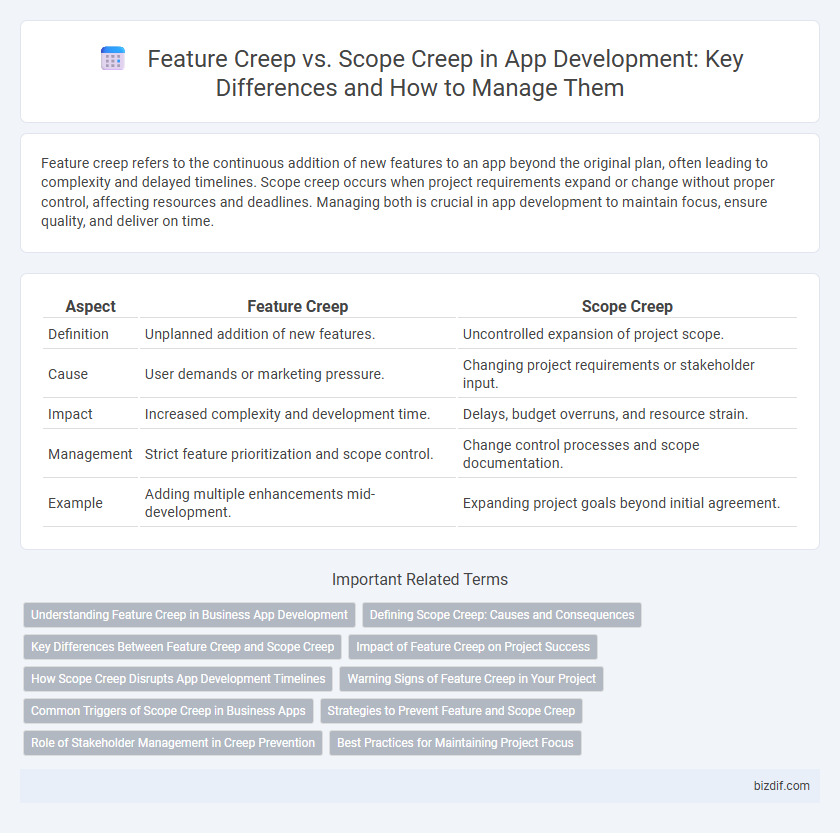Feature creep refers to the continuous addition of new features to an app beyond the original plan, often leading to complexity and delayed timelines. Scope creep occurs when project requirements expand or change without proper control, affecting resources and deadlines. Managing both is crucial in app development to maintain focus, ensure quality, and deliver on time.
Table of Comparison
| Aspect | Feature Creep | Scope Creep |
|---|---|---|
| Definition | Unplanned addition of new features. | Uncontrolled expansion of project scope. |
| Cause | User demands or marketing pressure. | Changing project requirements or stakeholder input. |
| Impact | Increased complexity and development time. | Delays, budget overruns, and resource strain. |
| Management | Strict feature prioritization and scope control. | Change control processes and scope documentation. |
| Example | Adding multiple enhancements mid-development. | Expanding project goals beyond initial agreement. |
Understanding Feature Creep in Business App Development
Feature creep in business app development refers to the uncontrolled addition of new features that extend beyond the original project requirements, leading to increased complexity and delayed delivery. This phenomenon often results in resource strain, higher costs, and decreased app performance due to overloading the application with unnecessary functionalities. Managing feature creep requires clear project scope definitions, prioritization of core features, and frequent stakeholder communication to ensure development remains aligned with business objectives.
Defining Scope Creep: Causes and Consequences
Scope creep in app development occurs when project requirements expand beyond the initial plan without corresponding adjustments in time, budget, or resources. Common causes include unclear project objectives, insufficient stakeholder communication, and evolving user demands. Consequences often involve missed deadlines, inflated costs, and compromised app quality, highlighting the need for strict change management processes.
Key Differences Between Feature Creep and Scope Creep
Feature creep involves the continuous addition of new features beyond the original project plan, often leading to increased complexity and delayed delivery. Scope creep refers to the uncontrolled expansion of project goals and deliverables, impacting timelines and resources without formal approval. Understanding these key differences helps project managers maintain focus and control during app development.
Impact of Feature Creep on Project Success
Feature creep significantly impacts project success by increasing development time and inflating budgets beyond initial estimates. Uncontrolled addition of features leads to resource strain, reduced product quality, and delayed market launch. Effective project management must prioritize clear requirements to mitigate the risks associated with feature creep and ensure timely delivery.
How Scope Creep Disrupts App Development Timelines
Scope creep in app development occurs when project requirements expand beyond the original plan, leading to unforeseen tasks and extended timelines. This continuous addition of features or changes disrupts resource allocation, causes delays in milestone completions, and increases the risk of project overruns. Managing scope creep through clear documentation and stakeholder communication is essential to maintain scheduled app delivery dates.
Warning Signs of Feature Creep in Your Project
Warning signs of feature creep in app development include frequent requests for new functionalities that extend beyond the original project plan, ambiguous or evolving requirements from stakeholders, and continuous changes during development cycles without proper evaluation. Increased project timelines and budget overruns often signal uncontrolled addition of features, leading to compromised app stability and user experience. Detecting these indicators early helps maintain project scope, ensuring efficient resource allocation and timely delivery.
Common Triggers of Scope Creep in Business Apps
Common triggers of scope creep in business app development include unclear project requirements, frequent stakeholder changes, and inadequate initial planning. Miscommunication between developers and clients often leads to additional features being requested mid-development without proper impact assessment. Lack of a structured change management process further exacerbates scope creep, causing delays and budget overruns.
Strategies to Prevent Feature and Scope Creep
Implement strict project documentation and clear requirement definitions to prevent feature and scope creep in app development. Regular stakeholder communication and iterative review cycles help maintain alignment with project goals and identify deviations early. Employing agile methodologies with prioritized backlogs ensures controlled addition of features without compromising project scope.
Role of Stakeholder Management in Creep Prevention
Effective stakeholder management plays a crucial role in preventing feature creep and scope creep in app development by ensuring clear communication of project goals and priorities. Regularly engaging stakeholders helps align their expectations, limiting the introduction of unnecessary features or expansions beyond the original scope. This proactive approach reduces risks of budget overruns, delays, and compromised app quality.
Best Practices for Maintaining Project Focus
Defining clear project requirements and adhering to an approved scope document are essential best practices for maintaining focus in app development, preventing feature creep and scope creep. Regular stakeholder communication combined with iterative sprint reviews helps ensure alignment and timely identification of out-of-scope changes. Implementing a robust change management process allows teams to evaluate requested modifications against project goals, minimizing distractions and ensuring deliverable quality.
Feature Creep vs Scope Creep Infographic

 bizdif.com
bizdif.com